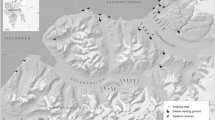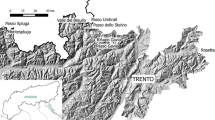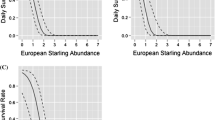Abstract
Interference competition over shared resources is expected to be intensive in harsh environments between phylogenetically and morphologically similar species. We document interspecific dominance and nest habitat selection by two pika-burrow nesting Montifringilla species, white-rumped snowfinches M. taczanowskii (WRS), and rufous-necked snowfinches M. ruficollis (RNS), which commonly inhabit alpine meadows in the northeastern Tibetan plateau. Relative to the critical point (<0.60) for coexistence, high overlaps (0.68–0.86) between the two species in egg-laying date, nest site distribution and nesting burrow attributes suggested strong interspecific competition over these niches. This is also predicted by the ratios of inter-species body mass (1.4) and linear dimensions (1.1–1.2) below the minimum value (2.0 and 1.3) for stable coexistence of closely related species. Larger-sized WRS was behaviorally dominant over pikas and over small-sized RNS. Being dominant, WRS established nesting territories in areas with moderately steep slopes from which they required most of the food resources during the breeding season; in contrast, RNS exhibited no territoriality and had to nest at margins between WRS’s territories and fed at dispersed sites. For the same reason, WRS mainly used active, and RNS used inactive, pika burrows. The asymmetric competition over nesting habitats could contribute to the relatively high nesting success and breeding density of the superior species. We argue that there is a spectrum in interspecific competition strength, from stable coexistence to complete exclusion along a gradient of increased environmental harshness, and the guild of the two snowfinch species is at a mediate position of the spectrum.


Similar content being viewed by others
References
Aitken KEH, Martin K (2008) Plasticity in resource selection affects community responses to an experimental reduction in availability of a critical resource. Ecology 89:971–980. doi:10.1890/07-0711.1
Andrén H (1990) Despotic distributions, unequal reproductive success and population regulation in the jay Garrulus glandarius L. Ecology 71:1796–1803. doi:10.2307/1937587
Basset A (1995) Body size-related coexistence: an approach through allometric constraints on home range use. Ecology 76:1027–1035. doi:10.2307/1940913
Basset A, Angelis DL (2007) Body size mediated coexistence of consumers competing for resources in space. Oikos 116:1363–1377. doi:10.1111/j.0030-1299.2007.15702.x
Begon M, Harper JL, Townsend CR (1996) Ecology—individuals, populations, communities, 3rd edn. Blackwell, Oxford
Beltman JB, Haccou P, ten-Cate C (2004) Learning and colonization of new niches: a first step toward speciation. Evol Int J Org Evol 58:35–46
Bensch S, Hasselquist D (1991) Territory infidelity in the polygynous great reed warbler Acrocephalus arundinaceus: the effect of variation in territory attractiveness. J Anim Ecol 60:469–476. doi:10.2307/5418
Bisakowski T, Smith DG, Speiser R (1992) Niche overlap of two sympatric-nesting hawks Accipiter spp. in the New Jersey–New York highlands. Ecography 15:358–372. doi:10.1111/j.1600-0587.1992.tb00046.x
Cameron TC, Wearing HJ, Rohani P, Sait SM (2007) Two-species asymmetric competition: effects of age structure on intra- and inter-specific interactions. J Anim Ecol 76:83–93. doi:10.1111/j.1365-2656.2006.01185.x
Carothers JH, Jaksic FM (1984) Time as a niche difference: the role of interference competition. Oikos 42:403–406. doi:10.2307/3544413
Case TJ, Gilpin ME (1974) Interference competition in niche theory. Proc Natl Acad Sci USA 71:3073–3077. doi:10.1073/pnas.71.8.3073
Chase JM, Abrams PA, Grover JP, Diehl S, Chesson P, Holt RD (2002) The interaction between predation and competition: a review and synthesis. Ecol Lett 5:302–315. doi:10.1046/j.1461-0248.2002.00315.x
Cheng TH (1983) The avifauna of Tibet. Science Press, Beijing, pp 312–316
Cody ML (1985) An introduction to habitat selection in birds, in habitat selection in birds. Cody ML (ed) Academic Press, New York, pp 3–56
Connell JH (1980) Diversity and coevolution of competitors, or the ghost of competition past. Oikos 35:131–138. doi:10.2307/3544421
Connell JH (1983) On the prevalence and relative importance of interspecific competition: evidence from field experiments. Am Nat 122:661–696. doi:10.1086/284165
Daily GC, Ehrlich PR (1994) Influence of social status on individual foraging and community structure in a bird guild. Oceologia 100:153–165. doi:10.1007/BF00317142
Dhondt AA (1977) Interspecific competition between great and blue tits. Nature 268:521–523. doi:10.1038/268521a0
Eccard JA, Ylönen H (2002) Direct interference or indirect exploitation? An experimental study of fitness costs of interspecific competition in voles. Oikos 99:580–590. doi:10.1034/j.1600-0706.2002.11833.x
Ens BJ, Kersten M, Brenninkmeijer A, Hulscher JB (1992) Territory quality, parental effort and reproductive success of oystercatchers (Haematopus ostralegus). J Anim Ecol 61:703–715. doi:10.2307/5625
Fu TS (1998) Fauna Sinica. Aves. Passeriformes: Ploceidae, Fringillidae, vol 14. Science Press, Beijing, pp 31–47
Ganeshaiah KN, Kumar ARV, Chandrashekara K (1999) How much should the Hutchinson ratio be and why? OikosIKOS 87:201–203. doi:10.2307/3547014
Gehrt SD, Prange S (2007) Interference competition between coyotes and raccoons: a test of the mesopredator release hypothesis. Behav Ecol 18:204–214. doi:10.1093/beheco/arl075
Giller PS (1984) Community structure and the niche. Chapman & Hall, London
Gorman OT (1988) The dynamics of habitat use in a guild of Ozark minnows. Ecol Monogr 58:1–18. doi:10.2307/1942631
Grant PR (1999) Ecology and evolution of Darwin’s finches, 2nd edn. Princeton University Press, Princeton
Hutchinson GE (1959) Homage to santa rosalia, or why are there so many kinds of animals? Am Nat 93:145–159. doi:10.1086/282070
Keddy PA (2001) Competition. Kluwer, Dordrecht
Krüger O (2002) Analysis of nest occupancy and nest reproduction in two sympatric raptors: common buzzard Buteo buteo and goshawk Accipiter gentilis. Ecography 25:523–532. doi:10.1034/j.1600-0587.2002.250502.x
Landmann A, Winding N (1993) Niche segregation in high-altitude Himalayan chats (Aves, Turdidae): does morphology match ecology? Oecologia 95:506–519
Landmann A, Winding N (1995a) Adaptive radiation and resource partitioning in Himalayan high-altitude finches. Zoology 99:8–20
Landmann A, Winding N (1995b) Guild organization and morphology of high-altitude granivorous and insectorous birds: convergent evolution in an extreme environment. Oikos 73:237–250. doi:10.2307/3545914
Leyequién E, Boer WF, Cleef A (2007) Influence of body size on coexistence of bird species. Ecol Res 22:735–741. doi:10.1007/s11284-006-0311-6
Lü XM, Zheng D (2006) Impacts of global change on the alpine meadow ecosystem in the source region of the Yangtze River. Resour Environ Yangtze Basin 15:603–607
MacArthur R (1972) Geographical ecology. Princeton University Press, Princeton
Maguire GS (2006) Territory quality, survival and reproductive success in southern emu-wrens Stipiturus malachurus. J Avian Biol 37:579–593. doi:10.1111/j.2006.0908-8857.03757.x
Martin K, Wiebe KL (2004) Coping mechanisms of alpine and arctic breeding birds: extreme weather and limitations to reproductive resilience. Integr Comp Biol 44:177–185. doi:10.1093/icb/44.2.177
Martin PR, Martin TE (2001) Ecological and fitness consequences of species coexistence: a removal experiment with wood warblers. Ecology 82:189–206
Martin TE (1998) Are microhabitat preferences of coexisting species under selection and adaptive? Ecology 79:656–670
Martin K, Eadie JM (1999) Nest Webs: a community wide approach to the management and conservation of cavity nesting birds. For Ecol Manage 115:243–257. doi:10.1016/S0378-1127(98)00403-4
Maurer BA (1982) Statistical inference for MacArthur–Levins niche overlap. Ecology 63:1712–1719. doi:10.2307/1940113
Morse DH (1974) Niche breadth as a function of social dominance. Am Nat 108:818–830. doi:10.1086/282957
Morten O, Per W (2007) Predicting spacing behavior and mating systems of solitary cervids: a study of hog deer and Indian muntjac. Zoology 110:261–270. doi:10.1016/j.zool.2007.03.003
Nilsson SG (1987) Limitation and regulation of population density in the nuthatch Sitta europaea (Aves) breeding in natural cavities. J Anim Ecol 56:921–937. doi:10.2307/4957
Pasinelli G (2007) Nest site selection in middle and great spotted woodpeckers Dendrocopos medius & D. major implications for forest management and conservation. Biodivers Conserv 16:1283–1298. doi:10.1007/s10531-007-9162-x
Persson L (1985) Asymmetrical competition: are larger animals competitively superior? Am Nat 126:261–266. doi:10.1086/284413
Potapov RL (1966) The birds of the Pamir. Tr Zoologicheskogo Inst AN SSSR 39:3–119
Potapov RL (2004) Adaptation of birds to life in high mountains in Eurasia. Acta Zool Sin 50:970–977
Przybylo R, Wiggins DA, Merila J (2001) Breeding success in blue tits: good territories or good parents? J Avian Biol 32:214–218. doi:10.1111/j.0908-8857.2001.320302.x
Qu YH, Lei FM, Yin ZH (2006) Molecular phylogenetic relationship of snow finch complex (genera Montifringilla, Pyrgilauda, and Onychostruthus) from the Tibetan plateau. Mol Phylogenet Evol 40:218–226. doi:10.1016/j.ympev.2006.02.020
Ricklefs R (1975) Competition and the structure of bird communities. Evol Int J Org Evol 29:581–584. doi:10.2307/2407272
Schluter D (1988) Character displacement and the adaptive divergence of finches on islands and continents. Am Nat 131:799–824. doi:10.1086/284823
Schluter D (2001) Ecology and the origin of species. Trends Ecol Evol 16:372–380. doi:10.1016/S0169-5347(01)02198-X
Schoener TW (1974) Resource partitioning in ecological communities. Science 185:27–39. doi:10.1126/science.185.4145.27
Selås V (1997) Nest-site selection by four sympatric forest raptors in southern Norway. J Raptor Res 31:16–25
Shelley EL, Tanaka MYU, Ratnathicam AR, Blumstein DT (2004) Can Lanchester’s laws help explain interspecific dominance in birds? Condor 106:395–400. doi:10.1650/7424
Tokeshi M (1999) Species coexistence: ecological and evolutionary perspectives. Blackwell Science, Oxford
Török J (1990) Resource partitioning among three woodpecker species Dendrocopos spp. during the breeding season. Ecography 13:257–264. doi:10.1111/j.1600-0587.1990.tb00617.x
Török J, Tóth L (1999) Asymmetric competition between two tit species: a reciprocal removal experiment. J Anim Ecol 68:338–345. doi:10.1046/j.1365-2656.1999.00283.x
Wang CT, Long RJ, Wang QJ, Ding LM, Wang MP (2007) Effects of altitude on plant-species diversity and productivity in an alpine meadow, Qinghai-Tibetan plateau. Aust J Bot 55:110–117. doi:10.1071/BT04070
Wauters L, Dhondt AA (1990) Red Squirrel (Sciurus vulgaris Linnaeus, 1758) population dynamics in different habitats. Z Saugetierkd 55:161–175
Zhang XA (1982) Studies on breeding biology of 10 species of passerine birds in alpine meadow. Acta Zool Sin 28:190–199
Zheng GM (2002) A checklist on the classification and distribution of the birds of the world. Science Press, Beijing
Acknowledgments
We are grateful to N.F. Liu for his advice and to B. Du, W.B. Liao, H.Y. Mu, and the staff of Gahai Nature Reserve, especially to R.C. Tian, Y. Zhang, and J.Z. Li for their help with the field work. We are indebted to L.X. Sun and an anonymous reviewer for their critical comments on the manuscript. This work was conducted in the Field Research Station for Tibetan Wildlife, which is jointly administered by Wuhan University and Tibet University. Financial support was provided by the National Sciences Foundation of China (grants 30425036 and 30670337).
Author information
Authors and Affiliations
Corresponding author
About this article
Cite this article
Zeng, X., Lu, X. Interspecific dominance and asymmetric competition with respect to nesting habitats between two snowfinch species in a high-altitude extreme environment. Ecol Res 24, 607–616 (2009). https://doi.org/10.1007/s11284-008-0530-0
Received:
Accepted:
Published:
Issue Date:
DOI: https://doi.org/10.1007/s11284-008-0530-0




